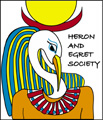

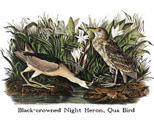
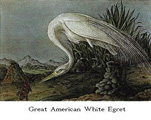
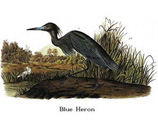

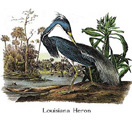
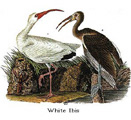
 |
 |
 |
 |
 |
 |
 |
 |
PLATE CCCLXIII.--ADULT MALE AND YOUNG.
 Genus
ARDEA NYCTICORAX, Linn. [Nycticorax nycticorax.]
Genus
ARDEA NYCTICORAX, Linn. [Nycticorax nycticorax.]
The Night Heron is a constant resident in the Southern
States, where it is found in abundance in the low swampy tracts near the coast, from the mouth of
the Sabine river to the eastern boundaries of South Carolina. On the whole of
that vast extent of country, it may be procured at all seasons. The adult birds
keep farther south than the young, flocks of the latter remaining in South
Carolina during the whole winter, and there the Night Herons are at that period
more common than most other species of the family. In that State it is named
"the Indian Pullet," in Lower Louisiana the Creoles call it "Gros-bec," the
inhabitants of East Florida know it under the name of "Indian Hen," and in our
Eastern States its usual appellation is "Qua-bird."
In the course of my winter rambles through East Florida, I met with several
of the large places of resort of Night Herons, and, in particular, one
remarkable for the vast number of birds congregated there. It is about six
miles below the plantation of my friend JOHN BULOW, Esq., on a bayou which opens
into the Halifax river. There several hundred pairs appeared to be already
mated, although it was only the month of January; many of the nests of former
years were still standing, and all appeared to live in peace and contentment.
My friend JOHN BACHMAN is acquainted with a place on Ashley river, about four
miles distant from Charleston, where, among the branches of a cluster of
live-oak trees, he has for the last fifteen years found a flock of about fifty
of these birds during the winter. They were all young, not a single individual
having been observed in the adult plumage, which is the more remarkable, because
it is usual for young birds to retreat farther south during winter than the old.
It is very common at this period for the sportsmen near Charleston to take their
stand along the margins of the salt-water ponds, to which the Herons generally
resort about dusk; and they frequently obtain several shots in an evening, but
not a single old bird is known to have been killed at this season.
The Night Heron seldom advances very far into the country, but remains on
the low swampy lands along the coast. It is rare to see one farther up the
Mississippi than the mouth of the Arkansas, to which a few are at times induced
to go while rambling along the great stream. I never saw one, nor heard of any,
whilst in Kentucky, and I doubt much if they are ever seen in the upper parts of
the State of Tennessee. The distance of a hundred iniles from the tide-mark
appears to be the farthest extent of their inland movements. On the other hand,
they are fond of resorting to the islands along the coast, on many of which they
breed.
At the approach of spring, great numbers of those which have wintered far
south, leave their places of sojourn and migrate eastward, although probably an
equal number remain in the low lands of Louisiana and the Floridas during the
whole year. There, indeed, I have found them with eggs in April and May, and as
young birds just fledged were very abundant at the same places, I concluded that
these eggs were of the second laying. By the middle of March, the number of
Night Herons is seen to increase daily in the Carolinas, and, about a month
later, some make their appearance in the Middle Districts, where many remain and
breed. They are not abundant in the State of New York, are seen sparingly
breeding in Massachusetts, while only a few proceed to Maine, and farther
eastward they are looked upon as a great curiosity. In Nova Scotia,
Newfoundland, and Labrador, this species is quite unknown.
Some European writers have alleged, that the Night Heron is scarce in the
United States, and of rare occurrence even in the southern parts. I wish these
people had been with me and my friend BACHMAN, or with some of the many hundred
persons who reside in the Southern Districts, or have travelled from Louisiana
to North Carolina. How strange it would have appeared to such assertors of
notions, to have seen a boat load of Night Herons shot in the course of a few
hours, and that too in the winter season.
Excepting while breeding, this species is extremely shy and wary,
especially the adults. To approach them from a distance after they have seen
you, is no easy task. They seem to know the distance at which your gun can
injure them, they watch all your movements, and at the proper moment leave their
perches. Should you chance to crack a stick while advancing towards them, they
start at once, give a few raps with their wings, in the manner of the Common
Pigeon, and fly off as if delighted at your disappointment. On the contrary,
you may shoot them with ease, if you lie in wait near the places to which they
resort to roost by day, and at which they generally arrive singly, or a few at a
time, when, from your place of concealment among the trees, you may kill them
the moment they alight over your head, and at a short distance. In this manner
I have known forty or fifty procured by two sportsmen in the course of about two
hours. You may also not unfrequently shoot them at any hour of the day, by
starting them from secluded feeding-grounds, and thus I have shot a good many in
different parts of the United States, and even in the Middle Districts. They
are, however, rarely shot whilst on the ground, their hearing being still more
acute than that of the American Bittern, which prefers squatting in the grass to
flying off, when any noise is heard, whereas the Night Heron rises immediately.
This species breeds in communities around the stagnant ponds, either near
rice plantations or in the interior of retired and secluded swamps, as well as
on some of the sea-islands covered with evergreen trees. Their heronries are
formed either in low bushes, or in middle-sized or tall trees, as seems most
convenient or secure. In the Floridas, they are partial to the mangroves that
overhang the salt-water; in Louisiana, they prefer the cypresses; and in the
Middle States, they find the cedars most suitable. In some breeding-places
within a few miles of Charleston, which I visited in company with my friend JOHN
BACHMAN, the nests were placed on low bushes, and crowded together, some within
a yard of the ground, others raised seven or eight feet above it, many being
placed flat on the branches, while others were in the forks. Hundreds of them
might be seen at once, as they were built on the side of the bushes fronting the
water. Those which I found in the Floridas were all placed on the south-west
sides of mangrove islands, but were farther apart from each other, some being
only about a foot above high-water mark, while others were in the very tops of
the trees, which, however, scarcely exceeded twenty feet in height. In some
inland swamps in Louisiana, I saw them placed on the tops of tall cypress trees
about a hundred feet high, and along with those of Ardea Herodias, A. alba, and
some Anhingas. In the Jerseys I have found the Night Herons breeding on
water-oaks and cedars; and my friend THOMAS NUTTALL informs me, that "in a very
secluded and marshy island, in Fresh Pond, near Boston, there likewise exists
one of these ancient heronries; and though the birds have been frequently robbed
of their eggs, in great numbers, by mischievous boys, they still lay again
immediately after, and usually succeed in raising a second brood." The same
accurate observer remarks, that "about the middle of October, the Qua-birds
begin to retire from this part of Massachusetts, towards their southern winter
quarters, although a few of the young birds still linger occasionally to the
29th or 30th of that month." This last observation is a farther evidence of the
reluctance which the young of this species feel to go as far south during winter
as the old birds.
The nest of the Night Heron is large, flattish, and formed of sticks placed
in different directions, sometimes to the height of three or four inches. At
times it is arranged with so little care, that the young upset it before they
are able to fly. Many of the nests are annually repaired, and these birds, when
they have once found an agreeable settlement, return regularly to it, until some
calamity forces them to abandon it. The full number of the eggs is four, and
they measure at an average two inches and one-sixteenth by an inch and a half.
They are thin-shelled, and of a plain light sea-green colour. In about three
weeks after the young are hatched, most of them leave the nest, and crawl about
the branches, to which they cling firmly, ascending to the tops of the bushes or
trees, and there awaiting the return of their parents with food. If you
approach them at such times, the greatest consternation ensues both among the
young and the old birds; the loud and incessant croaking which both have until
then kept up, suddenly ceases; the parent birds rise in the air, sail around and
above you, some alighting on the neighbouring trees; while the young scramble
off in all directions to avoid being taken. So great at times is their terror,
that they throw themselves into the water, and swim off with considerable
rapidity, until they reach the shore, when they run and hide in every convenient
place. Retire for half an hour, and you will be sure to hear the old and the
young calling to each other; the noise gradually increases, and in a short time
is as loud as ever. The stench emitted by the excrements with which the
abandoned nests, the branches and leaves of the trees and bushes, and the
ground, are covered, the dead young, the rotten and broken eggs, together with
putrid fish and other matters, renders a visit to these places far from
pleasant. Crows, Hawks and Vultures torment the birds by day, while Racoons and
other animals destroy them by night. The young are quite as good for eating as
those of the Common Pigeon, being tender, juicy, and fat, with very little of
the fishy taste of many birds which, like them, feed on fishes and reptiles. At
this period few if any of the old birds have the long feathers of the hind head,
and these are not reproduced before the latter part of the following winter,
when they seem to attain their extreme length in a few weeks.
The flight of the Night Heron is steady, rather slow, and often greatly
protracted. They propel themselves by regular flappings of the wings, and, like
the true Herons, draw in their head on the shoulders, while their legs stretch
out behind, and with the tail form a kind of rudder. When alarmed they at times
rise high in the air, and sail about for awhile. They sail in the same manner
before alighting on their feeding grounds, which they rarely do without having
previously attended to their security by alighting on the neighbouring trees and
looking about them. Their migrations are performed under night, when their
passage is indicated by their loud hoarse notes, resembling the syllable qua,
uttered at pretty regular intervals. On these occasions they appear to fly
faster than usual.
On the ground, this bird exhibits none of the grace observed in all the
true Herons; it walks in a stooping posture, the neck much retracted, until it
sees its prey, when, with a sudden movement, it stretches it out and secures its
food. It is never seen standing motionless, waiting for its prey, like the true
Herons, but is constantly moving about in search of it. Its feeding places are
the sides of ditches, meadows, the shady banks of creeks, bayous, and ponds or
rivers, as well as the extensive salt-marshes and mud-bars left exposed at low
water; and I have observed it to alight in the ponds in the suburbs of
Charleston towards evening, and feed there. In all such situations, excepting
the last, this bird may often be seen by day, but more especially in the evening
or morning twilight, wading up to its ankles, or, as we commonly say, its
knee-joints. Its food consists of fishes, shrimps, tadpoles, frogs,
water-lizards, and leeches, small crustacea of all kinds, water insects, moths,
and even mice, which seem not less welcome to it than its more ordinary articles
of food. When satisfied, it retires to some high tree on the banks of a stream
or in the interior of a swamp, and there it stands, usually on one leg, for
hours at a time, apparently dosing, though seldom sound asleep.
When wounded, this bird first tries to make its escape by hiding among the
grass or bushes, squatting the moment it finds what it deems a secure place; but
if no chance of a safe retreat occurs, it raises its crest, ruffles its
feathers, and, opening its bill, prepares to defend itself. It can bite pretty
severely, but the injury inflicted by its bill is not to be compared with that
produced by its claws, which on such occasions it uses with much effect. If you
seize it, it utters a loud, rough, continued sound, and tries to make its escape
whenever it perceives the least chance.
The Night Heron undergoes three annual changes of plumage ere it attains
its perfect state, although many individuals breed in the spring of the third
year. After the first autumnal moult, the young is as you see it represented in
the plate. In the second autumn, the markings of the neck and other parts have
almost entirely disappeared; the upper parts of the head have become of a dull
blackish-green, mixing near the upper mandible with the dull brown of the first
season, while the rest of the plumage has assumed a uniform dull ochreous
greyish-brown. In the course of the following season, the bird exhibits the
green of the shoulders and back, the head is equally richly coloured, and the
frontal band between the upper mandible and the eye, and over the latter, is
pure white. At this age it rarely has the slender white feathers of the hind
head longer than an inch or two. The sides of the neck, and all the lower
parts, have become of a purer greyish-white. The wings are now spotless in all
their parts, and of a light brownish-grey, as is the tail. The following
spring, the plumage is complete, and the bird is as represented in the plate.
After this period, with the exception of losing its long crest-feathers after
the young are hatched, it retains its colouring. No difference can be observed
in the tints of the sexes, but the male is somewhat larger.
A very considerable difference in size is observable at all seasons in
birds of this species. Some that are fully feathered, and therefore at least
three years old, measure as much as four inches less than others of the same
sex, and weigh less in proportion. These circumstances might suffice with some
naturalists to attempt to form two species out of one, but in this they would
certainly fail.
In the neighbourhood of New Orleans, and along the Mississippi as far up as
Natchez, the shooting of this species is a favourite occupation with the
planters, who represent it as equalling any other bird in the delicacy of its
flesh.
The frog, of which I have introduced a figure, is common in the retired
swamps which the Night Heron frequents, and is often devoured by it. The
flowering plants which you see, are abundant in the States of Georgia and South
Carolina, as well as in the Floridas.
NIGHT HERON OR QUA-BIRD, Ardea Nycticorax, Wils. Amer. Orn., vol. vii.p. 3.
ARDEA NYCTICORAX, Bonap. Syn., p. 306.
QUA-BIRD OR AMERICAN NIGHT HERON, Ardea discors, Nutt. Man., vol. ii.p. 54.
NIGHT HERON, Ardea Nycticorax, Aud. Orn. Biog., vol. iii. p. 275;vol. v. p. 600.
Male, 25 7/12, 44.
Resident in the Floridas and Texas, where it breeds. Migrates in spring
eastward as far as Maine, up the Mississippi to Memphis. Occurs one hundred
miles inland. Rather common. Returns southward early in autumn.
Adult Male, in Spring.
Bill a little longer than the head, strong, straight, compressed, tapering.
Upper mandible with the dorsal line slightly arched and declinate, the ridge
broad and rather rounded at the base, narrowed towards the end, the sides
sloping, the edges very sharp and inflected, obscurely serrated with minute
oblique slits, and having a distinct notch close to the compressed, rather
obtuse tip. Nasal groove wide at the base, extending narrow to near the tip;
nostrils basal, linear, wider behind, longitudinal. Lower mandible with the
angle very long and narrow, the dorsal line straight and sloping upwards, the
sides flat, the sharp obscurely jagged edges slightly inflected, the tip very
acute.
Head oblong, much compressed; eyes large. Neck long. Body rather slender,
compressed. Feet rather long, robust; tibia bare at its lower part; tarsus
covered anteriorly along its upper two-thirds with scutella, below and on the
sides with large angular scales; toes long and rather slender, scutellate above,
flat beneath, marginate; hind toe stout, fourth a little longer than second,
third much longer; claws of moderate size, stout, arched, compressed, rather
acute, that of middle toe beautifully pectinate on the inner edge.
Plumage soft, blended. Feathers of the upper and hind part of the head
elongated and loose, with three very long, linear incurved occipital feathers,
having their webs inflected. The feathers of the neck, especially of its lower
part and sides, are also elongated, the latter curved backwards. Wings of
moderate length, broad, rounded; primaries broad, rounded, the third longest,
the first longer than the fourth. Tail short, slightly rounded, of twelve
broad, rounded feathers.
Bill black. Bare ]oral space and eyelids yellowish-green; iris bright red.
Feet yellow; claws brown. Feathers on the upper part of the head, the fore part
of the back, and the scapulars, glossy blackish-green; anterior part of forehead
white; neck anteriorly white, on the sides and behind shaded into pale lilac,
the lower elongated feathers tinged with cream-colour; breast and abdomen white,
similarly tinged. Wings, rump, and tail, light greyish-blue, tinged with lilac.
Length to end of tail 25 7/12 inches, to end of wings 25 10/12, to end of
claws 30 4/12; extent of wings 44; wing from flexure 13 3/4; tail 5; bill along
the ridge 3 2/12, along the edge of lower mandible 4 2/12; bare part of tibia
1 1/4; tarsus 3 1/4; middle toe 3; its claw (7 1/2)/12. Weight 1 lb. 14 oz.
Young after first moult.
Bill and bare space about the eye yellowish-green, the ridge of the upper
mandible, and paint of the lower towards the end, black. Iris bright red. Feet
pale greyish-yellow. At this period the occipital feathers are not developed.
The general colour of the upper parts is light greyish-brown, the edges of the
feathers paler; that of the lower parts dull white, tinged with grey and cream
colour, with the central part of each feather greyish-brown; the feathers of the
back and wings, as well as the secondary quills, have a long triangular spot of
brownish-white at the end; the rump and tail more tinged with bluish-grey.
The Adult Female resembles the Male.
AMARYLLIS ATAMASCO, Willd. Sp. Pl., vol. ii. p. 51. Pursh, Flora Amer.
Sept., vol. i. p. 222.
This species, which grows in swamps, and moist woods, in Virginia and
Carolina, is characterized by having an acute bifid spatha, an erect
funnel-shaped corolla of a pale rose-colour or pure white, with a short tube at
the base, the segments nearly equal, as are the declinate stamens. It flowers
in June and July, and attains a height of from eight inches to a foot.